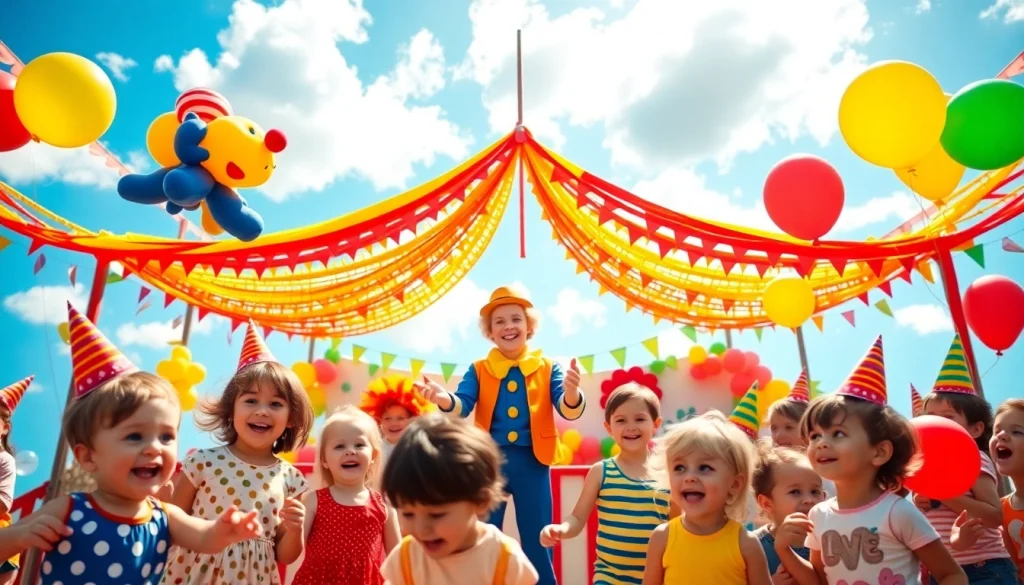
Defining Kids Entertainment
What is Kids Entertainment?
Kids entertainment comprises a diverse set of activities specifically designed to engage children in enjoyable and amusing ways. It includes a wide range of options, from traditional performances like puppet shows to modern experiences such as interactive digital games. Understanding the nuances of kids entertainment is essential for parents, educators, and professionals in the industry to create age-appropriate, engaging experiences for children.
Key Elements of Effective Kids Entertainment
Effective kids entertainment not only captivates children’s attention but also serves educational purposes. Some key elements include:
- Interactivity: Activities that involve participation rather than passive observation keep kids engaged and encourage creativity.
- Safety: Ensuring that environments and activities are safe is critical, as children require supervision and proper materials.
- Age Appropriateness: Content must be suitable for the children’s development stages to maximize understanding and enjoyment.
Importance of Engaging Activities for Children
Engaging children in entertainment plays a crucial role in their development. It not only provides joy but also promotes essential skills such as teamwork, problem-solving, and emotional development. Activities that stimulate creativity and learning help children grow into well-rounded individuals.
Types of Kids Entertainment
Interactive Activities and Shows
Interactive activities, such as workshops and live performances that require audience participation, are highly effective for capturing children’s attention. These can range from theatrical productions where kids act alongside professionals to hands-on arts and crafts activities that align with themes from popular children’s books.
Outdoor vs Indoor Entertainment Options
Both outdoor and indoor entertainment options have their advantages. Outdoor activities like inflatable bounce houses, treasure hunts, and nature scavenger hunts promote physical activity and exploration. In contrast, indoor options such as science experiments, arts and crafts, and magic shows allow for creativity and imagination, irrespective of weather conditions.
Digital Entertainment Trends for Kids
The digital landscape has transformed the way children engage with entertainment. Online games, educational apps, and streaming services provide endless content tailored to various age groups. However, moderation and supervision are vital, ensuring that screen time is balanced with physical activities.
Planning a Successful Kids Entertainment Event
Choosing the Right Theme and Activities
Choosing a compelling theme is essential for the success of any kids entertainment event. Whether it’s a superhero party, a princess-themed gathering, or a science exploration day, themes help create an immersive atmosphere. Activities should align with the theme, offering games, crafts, and performances that tie into the storyline.
Logistics and Venue Considerations
Logistics play a significant role in planning a successful event. Selecting an appropriate venue that can accommodate your expected guest list and offers the necessary amenities is crucial. Ensure that the venue has safe play areas and ample space for activities. Additionally, consider accessibility for parents and caregivers.
Budgeting for Kids Entertainment
Budgeting effectively ensures that your event offers value without overspending. Determine costs for venue rental, performer fees, supplies, and marketing materials. Set priorities on the must-haves versus nice-to-haves. Seeking sponsorships from local businesses can also alleviate some financial burdens while enhancing community engagement.
Marketing Your Kids Entertainment Offerings
Effective Strategies for Reaching Parents
To attract parents to your kids entertainment offerings, consider their unique needs and preferences. Create informative and appealing marketing materials that highlight the benefits of your activities. Use local parenting groups, schools, and community centers as platforms to share your events.
Leveraging Social Media for Visibility
Social media offers an interactive platform to engage with potential clients. Post engaging content, share photos from past events, and run contests to generate interest. Pair eye-catching visuals with compelling stories to resonate with both parents and children.
Building Partnerships with Local Businesses
Collaborating with local businesses can enhance your event’s visibility and credibility. Partner with businesses that target similar demographics, like toy stores or children’s clothing shops. Consider cross-promotions that allow for shared marketing efforts and community solidarity.
Measuring Success in Kids Entertainment
Gathering Feedback from Parents and Kids
Post-event feedback is invaluable for gauging success and identifying areas for improvement. Collect both qualitative and quantitative feedback. This could include surveys for parents regarding their children’s enjoyment and engagement, as well as children’s reflections on their favorite aspects of the event.
Key Performance Indicators for Kids Events
Establishing key performance indicators (KPIs) helps measure the event’s impact. Metrics could include attendance rates, engagement levels during activities, and satisfaction ratings from participants. This data drives decisions for future improvements and marketing strategies.
Adapting Based on Audience Responses
Being responsive to audience feedback allows for continuous improvement of your entertainment offerings. If certain activities prove popular, consider incorporating them into future events or expanding on those themes. Conversely, recognizing less successful aspects enables you to pivot and try new approaches.




